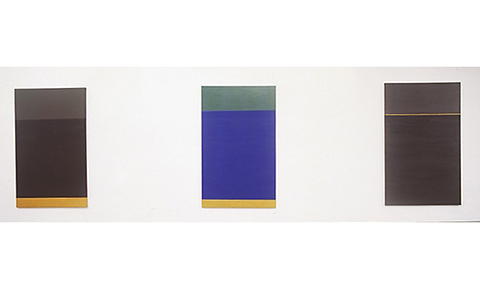1995
Appearance and Dissimilarity - Rodrigo Naves
Galeria Millan
An observation by Sartre with respect to The Stranger by Camus might provide us a point of entry into the work of Renata Tassinari. Remarking on the combination of naturalness and strangeness that permeates the book, Sartre notes that between his characters and the reader, Camus places a glass partition. The glass appears to let everything through except one thing: the meanings of gestures.Even the most prosaic actions lose their normalcy while existence itself, little by little, becomes opaque, while still familiar.
Renata Tassinari´s pictures show something similar. At first, the vivacity of their colors, particularly in the exhibitions of 1989 and 1993, both at Galeria Millan, win us over. The coexistence between joyful colors and the considerable variety of areas in which they appear suggests a prodigal and generous world, composed of unsoiled relations, which reveal themselves clearly to the senses. A tender grace aerates this reality, unconcerned with origins or foundations. Life appears governed by a tranquil measure, capable of connecting the most divergent movements.
But slowly these tranquil appearances begin to cloud. Wrapped in the wax that binds them, colors hesitate to show themselves openly. A thin membrane emerges between what would have been the colors and what we actually see. Murkiness covers them from head to toe. Everything in these pictures appears to oscillate between a shadowy sedimentation of the pigments which, then, no longer rise to the surface and a determined affirmation of their presence. As in Sartre´s observation, we are divided between recognition of an everyday phenomenon color and its refracted, shifty manifestation. Colors now point to recalcitrant occurrences instead of that serene certainty that presented itself at the outset.
The works in the current exhibition pose the same questions that moved the earlier works, but on a new plane. The unresolved relation between clarity and murkiness remains; however, it does so using more restrained tones and a simpler articulation of the color areas. Now, despite this simplification, the interplay between the geometric rigor of the surfaces and their somewhat diffuse final appearance originates from a more intense dialogue between the sections of the canvas, making the obstruction resulting from the encaustic somewhat less necessary.
In one of these pictures, the golden band at the base intensifies (and is intensified by) the strength of the ample stretch of black that lies above it. The contrast between both gives motion to the darker area, transforming it into a process instead of a simple reiteration of a given tonality. However, this movement has a surprising outcome: in its development, the black leads to a slightly lighter, somewhat tobacco-colored area. Paradoxically, its affirmation appears to deflect it from itself, creating a dubious area where one no longer knows for certain what is limit, outcome, or dilution. The lack of correspondence between color and its footprint removes, from the black surface, any relationship of identity with its material base. In its movement forward, it appears to unhinge from the layer of paint and hover supremely over the support. This affirmation has, therefore, something in the nature of banishment.
Similar movements occur in almost all the works. In one, a blue field is confronted with a long graphite surface. The differences in size and color generate an interaction that could have resulted, who knows, in equilibrium and unity. But this promise is not fulfilled. The thick presence of the graphite inhibits the gentle expansion of the blue. (To the right, the narrow golden stripe underscores this contained relationship.) The contrast between luminosity (blue) and body (graphite) is incapable of generating an exchange that might transfer to each the qualities of the other. Body and light become mutually exclusive, each appearing to fulfill the hopes of the other without ever completing this movement though we are constantly reminded of a potential synthesis that would generate corporeal light, a phenomenon of rare power that might offer us new horizons and unequaled plasticity.
Renata Tassinari´s works have an uncommon elegance. The ability to divide things to place them in proportion and confer lightness and vivacity is immediately enchanting. However, this ability to create distinct and discreet relationships,known as elegance, projects a strange shadow. What was made to be contemplated reveals a different nature: a layer beyond itself, to which it points, without revealing. Distinct precision and full and complex identities give way to a game of endless dislocations. I am not speaking of essences and appearances, of misleading phenomena or perverse illusions; that time is passed. These days it is hard to tell what is on this side and what is on that, if such things still exist. But, in these pictures, the image acquires an entirely particular statute. What is rendered visible shows a spectral consistency. The appearance of things has an excessive duration, or reveals a disquieting postponement. The most gracious objects have an air of phantasmagoria. The autonomy of the image, one of the prides of our day, may not be more than the shadow of a frightening reality.
